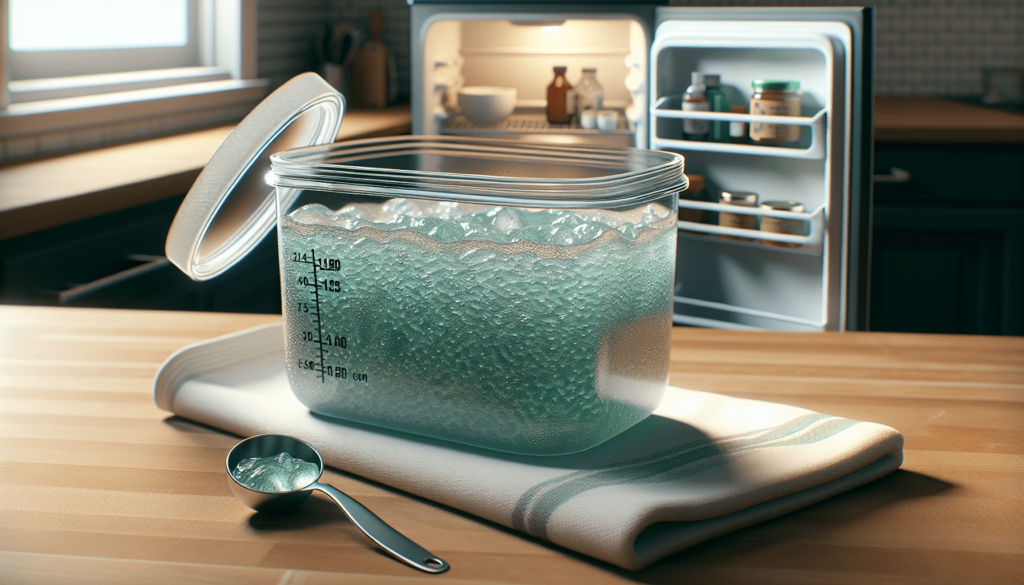The Best Fluffy Pancakes recipe you will fall in love with. Full of tips and tricks to help you make the best pancakes.

Imagine you’ve just made a fresh batch of homemade sea moss gel – a nutritious and versatile superfood. Now, you’re wondering how to properly store it to maintain its freshness and maximum benefits. Look no further! In this article, we will share simple yet effective tips on how to store sea moss gel, ensuring it stays at its optimal quality for an extended period. From the right temperature to the ideal container, we have got you covered. So, let’s dive in and discover the secrets of storing sea moss gel like a pro!
Choosing the Right Storage Container
When it comes to storing sea moss gel, choosing the right storage container is crucial to maintaining its freshness and quality. There are a few options to consider, such as glass or mason jars, plastic containers, and freezer bags. Each has its own pros and cons, so let’s explore them further.
Glass or Mason Jars
Glass or mason jars are excellent choices for storing sea moss gel. They are made from non-toxic materials and do not leach harmful chemicals into the gel. Additionally, glass jars are transparent, allowing you to easily see the contents inside. This makes it convenient to monitor the gel’s freshness and any changes that may occur over time. Furthermore, glass jars are environmentally friendly as they are reusable and recyclable.
Plastic Containers
Plastic containers are another common option for storing sea moss gel. However, it is essential to choose containers that are BPA-free and food-grade. BPA is a chemical often found in certain plastics that can potentially contaminate the gel and pose health risks. Look for containers specifically labeled as safe for food storage. Plastic containers are lightweight and durable, making them suitable for everyday use, but be mindful of their lifespan and the potential for wear and tear over time.
Freezer Bags
Freezer bags are a convenient option for freezing sea moss gel in smaller portions. These bags are designed to withstand freezing temperatures and are often made from durable materials that resist punctures and leaks. Freezer bags also allow for easy portioning and stackability in the freezer. However, they may not offer the same level of protection as glass jars or plastic containers, so it’s advisable to use them for short-term storage rather than long-term.
Refrigerator Storage
Properly storing sea moss gel in the refrigerator is essential for maintaining its freshness and preventing bacterial growth. Here are some key considerations:
Proper Temperature
To ensure the gel stays fresh, it is important to store it in the refrigerator at a temperature between 34 and 40 degrees Fahrenheit (1 to 4 degrees Celsius). This range helps to inhibit the growth of bacteria and extends the shelf life of the gel.
Sealing the Container
When storing sea moss gel in the refrigerator, it is crucial to seal the container tightly. This helps to prevent air from entering the container and slows down the oxidation process, which can cause the gel to spoil more quickly. Properly sealed containers also prevent any potential odors from infiltrating the gel and compromising its taste and quality.
Avoiding Contamination
To avoid contamination, always use a clean utensil when scooping out sea moss gel from the container. It is also important to refrain from storing other food items, such as raw meats or strong-smelling ingredients, in close proximity to the gel. This helps to maintain its natural flavor and prevents cross-contamination.

Freezing the Sea Moss Gel
Freezing sea moss gel is an effective way to extend its shelf life and have it conveniently available whenever you need it. Here are some tips for freezing sea moss gel properly:
Container Preparation
Before freezing sea moss gel, ensure that your chosen container is freezer-safe. Glass jars, plastic containers, and freezer bags are all suitable options. Clean and dry the container thoroughly to prevent any potential contamination or freezer burn.
Portioning the Gel
Consider portioning the sea moss gel before freezing it. Freezing individual servings can save you time later when you only need a small amount. It also helps to prevent unnecessary thawing and refreezing, which can affect the gel’s texture and quality.
Labeling and Dating
To keep track of your sea moss gel, label each container with the date of freezing. This way, you can easily identify how long each batch has been in the freezer and ensure you use the oldest gel first. Proper labeling also prevents confusion and helps avoid wastage.
Thawing and Using Frozen Sea Moss Gel
Thawing frozen sea moss gel properly is essential to retain its taste and texture. Here are a few steps to follow:
Slow Thawing
To preserve the gel’s quality, it is recommended to thaw it slowly in the refrigerator rather than using methods that involve heat or rapid thawing. Slow thawing allows the gel to defrost gradually, maintaining its smooth consistency and preventing any separation or texture changes.
Mixing the Gel
Once thawed, it is important to mix the gel thoroughly before using it. This helps to evenly distribute any moisture that may have separated during freezing and ensures a cohesive and consistent product.
Proper Refrigeration
After thawing and using the desired portion of sea moss gel, promptly return the remaining gel to the refrigerator. Remember to seal the container tightly to prevent air or moisture from entering. Proper refrigeration helps to maintain the gel’s freshness and prevents spoilage.

Extending Shelf Life with Preservatives
If you want to extend the shelf life of sea moss gel, you can consider using preservatives. Here are two options to explore:
Natural Preservatives
There are several natural preservatives that can help inhibit bacterial growth and maintain the freshness of sea moss gel. These include citric acid, vitamin C, and rosemary extract. Adding small amounts of these preservatives to your gel can help extend its shelf life without compromising its natural qualities.
Commercial Preservatives
Commercial preservatives specifically formulated for food preservation can also be used to extend the shelf life of sea moss gel. These preservatives often come in powder or liquid form and can be added according to the manufacturer’s instructions. It is important to carefully follow the recommended dosage to ensure the safety and effectiveness of the preservative.
Avoiding Common Mistakes
To ensure the longevity of your sea moss gel, it’s crucial to avoid some common mistakes that may compromise its quality:
Storing Wet Sea Moss
Before storing sea moss gel, ensure that it is properly strained and excess moisture is removed. Excess water can promote bacterial growth and result in spoilage, so it’s important to strain the gel thoroughly before storage.
Leaving Excess Air in the Container
When storing sea moss gel, it’s important to minimize excess air in the container. Leaving too much air can lead to oxidation and degradation of the gel, reducing its freshness and quality. Fill the container as much as possible to minimize the amount of air in contact with the gel.
Leaving the Gel Unsealed
Proper sealing of the container is vital to keep the gel fresh and prevent contamination. Leaving the gel unsealed exposes it to air and potential contaminants, leading to spoilage. Always remember to seal the container tightly after each use to maintain the quality of the sea moss gel.
Maintaining Quality and Freshness
To ensure the sea moss gel maintains its quality and freshness throughout its storage period, consider the following:
Avoiding Temperature Fluctuations
Stability in temperature is crucial for preserving the quality of sea moss gel. Fluctuating temperatures can accelerate the spoilage process and lead to an unpleasant taste and texture. Make sure to store the gel in a cool and consistent environment to maintain its freshness for as long as possible.
Regularly Inspecting the Gel
Periodically check the sea moss gel for any signs of spoilage or changes in consistency. Look out for mold growth, unpleasant odors, or unusual coloration. If you notice any of these signs, it’s best to discard the gel to ensure your safety and prevent any potential health issues.
Using a Clean Utensil
When accessing the gel from the container, always use a clean utensil to prevent cross-contamination. Using dirty utensils introduces bacteria and other unwanted elements that can degrade the gel’s quality. Regularly clean the utensil to maintain proper hygiene and freshness.
Long-Term Storage Options
If you need to store sea moss gel for an extended period, here are a few long-term storage options to consider:
Dehydrating the Gel
Dehydrating sea moss gel removes the moisture content, allowing it to be stored for an extended period without refrigeration. Dehydrated sea moss can be ground into a powder and stored in a cool, dry place for several months. However, keep in mind that this process alters the gel’s texture and may affect its usability in certain recipes.
Vacuum Sealing
Vacuum sealing is an excellent option for long-term storage of sea moss gel. It removes excess air and helps to maintain the gel’s freshness and quality. Vacuum-sealed bags can be stored in the refrigerator or freezer, depending on your preferences and the desired shelf life.
Using Ice Cube Trays
Another practical method for long-term storage is to freeze sea moss gel in ice cube trays. Portion the gel into individual compartments and freeze them. Once frozen, transfer the gel cubes to a freezer bag or airtight container. This method allows for easy portioning and thawing as needed.
By choosing the right storage container, properly storing, freezing, and thawing sea moss gel, and taking necessary precautions, you can enjoy the gel’s freshness and quality for an extended period. Remember to prioritize cleanliness and temperature control to maintain the optimal conditions for your sea moss gel storage.




